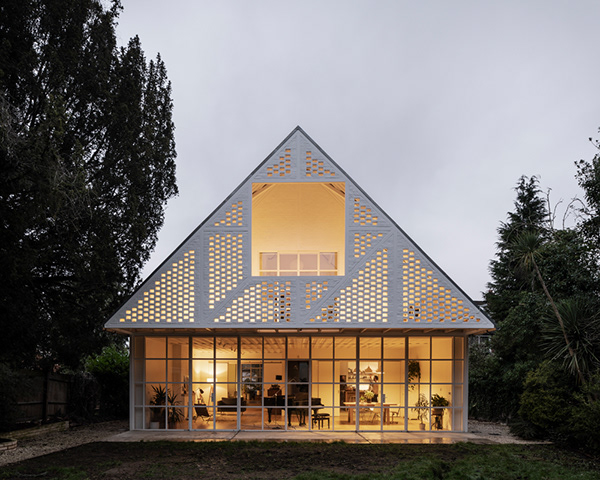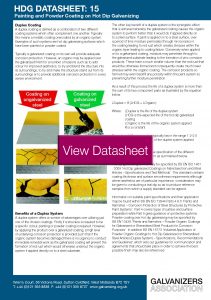Can you paint over galvanised steel?
Hot Dip Galvanizing by itself is a long lasting, cost effective means of corrosion protection. However, galvanised steel can be painted for the following reasons:
- add colour for aesthetic, camouflage, or safety purposes
- increase the economic life of a structure
- provide additional protection in very aggressive environments
All paint systems used should be specifically formulated for use on galvanized steel and applied in accordance with the paint manufacturer’s recommendations.
How to paint galvanized metal
Painting galvanised metal is very easy as long as the right steps are carried out. The following is a quick introduction for the process:
- Preparation of galvanized steel before painting. There are four recognised methods of surface pre-treatment that produce a sound substrate for a paint coating: t wash, etch primers, sweep blasting and weathering.
- Selecting the correct paint for galvanised metal. All paint systems should be specifically formulated for use on galvanized steel and applied in accordance with the paint manufacturer’s recommendations.
- Application of the paint coating should be carried out in accordance to the manufacturer’s instructions, i.e. time of application, dry film thickness and curing rates.
Step one can be skipped for direct application of paint over galvanised metals. A limited number of direct application products available which negate the need for chemical or mechanical pre-treatment to be conducted. These products are known to have been used in a variety of applications.
Do you need to prime galvanized metal before painting?
Applying a primer can be part of the pre-treatment of galvanised steel (read more below about How do you prepare galvanized steel before painting). However, it is not absolutely necessary, as mentioned before, there are a limited number of direct application products available which negate the need for chemical or mechanical pre-treatment.
How to prepare galvanized steel for painting
Guidelines for the pre-treatment for painting of galvanized metals have been drawn up as a result of (i) a study carried out by an independent research centre and a leading UK paint manufacturer into the performance of commercially available pre-treatment and paint systems and the parameters affecting their performance on hot dip galvanized coatings, and (ii) many years experience with duplex coatings.
Although pre-treatment of galvanized components is best carried out immediately after galvanizing, before the surface has become contaminated in any way, this is not always practical. Pre-treatment can be carried out later but it is vital that the surface is adequately cleaned to remove all traces of contaminants such as oil, grease and dirt. The cleaning operation must leave no residues on the cleaned surface and any wet storage staining should be removed using a stiff brush. Washing down the coating with water will help to remove soluble salts.
There are four recognised methods of surface pre-treatment that produce a sound substrate for a paint coating:
1. T-Wash (or its proprietary equivalent)
Despite the fact that this preparation process has been available for some considerable time, T-Wash is still generally considered to be the best pre-treatment method for painting galvanized steel.
T-Wash is a modified zinc phosphate solution which contains a small amount of copper salts. When applied, a dark grey or black discolouration of the zinc surface will result.
T-Wash must not be allowed to pool on horizontal surfaces or this will prevent maximum paint adhesion. Any excess should be removed by water.
How long can I leave the T-wash on galvanised steel for?
T-wash is most suitable for application to new galvanizing and should not be used on weathered galvanizing (see etch primers below). Sufficient time must be allowed for the T-Wash to react and dry thoroughly before the first coat of paint is applied. (Suppliers’ information will give recommended time intervals).
While research has shown that T-Washed surfaces can be left for up to 30 days before painting and good paint adhesion can still result, it is advisable to minimise the time between pre-treatment and paint application. Any white salt formed by the exposure of the T-Washed surface to moisture must be removed before painting, using a stiff brush. If the T-Washed surface has become contaminated it must be cleaned in accordance with the suppliers’ recommendations.
Constituents of T-Wash
The constituents of T-Wash are phosphoric acid (9.0%), ethyl cellusolve (16.5%), methylated spirit (16.5%), water (57.0%) and copper carbonate (1.0%). Variations to this composition may exist and so it is wise to consult the supplier if a successful result is to be achieved.
2. Etch primers
Etch primers have also been used successfully. Their major disadvantage is the absence of any visible colour change as is the case with T-Wash. Therefore, there can never be complete confidence that all surfaces have reacted with the primer. Etch primers are most suited to application on older, weathered galvanizing.
3. Sweep blasting
A mechanical method of pre-treatment is sweep blasting using fine copper slag, J blast or carborundum powder with a blast pressure of no greater than 40psi (2.7 bar). This will ensure that only the minimum amount of oxide is removed and the zinc surface is left in a slightly roughened condition. Care should be taken when carrying out sweep blasting on very thick galvanized coatings to avoid damage to the coating. The optimum nozzle-to-work piece distance and angle of blasting needs to be identified for all surfaces on the galvanized steelwork if optimum results are to be achieved. Angular iron blasting grit must not be used under any circumstances. Sweep blasting is often used in addition to the chemical preparation stage.
4. Weathering
This process only becomes fully effective after a galvanized surface has been exposed to the atmosphere for a period of at least six months. The surface is prepared using either abrasive pads or a stiff brush to remove all loose adherent materials and making sure that the bright zinc surface is not restored.
This is followed by a hot detergent wash and rinsing with fresh clean water. The surface must be fully dry before any paint is applied. Weathering should not be used as a method of surface preparation in marine environments with high chloride levels.
How to choose a paint for galvanised metal
All paint systems used should be specifically formulated for use on galvanized steel and applied in accordance with the paint manufacturer’s recommendations.

Paint on Galvanized Steel – Ditton Hill House – 2020 GAGA awards Duplex Winner
What kind of paint do you use on galvanized steel?
The choices of paint systems on galvanised metal will depend upon both the application and service environment. With the decline in the use of chlorinated rubber and alkyd paints, high-build epoxy products and vinyl/vinyl co-polymer systems are increasingly utilised with glass reinforced epoxy being an option for more severe environments. In multi-coat systems the use of micaceous iron oxide (MIO) primer has been shown to give improved adhesion.
Two-pack polyurethane and acrylic urethanes are commonly used as top coats and offer good durability and colour retention. Alternatives include acrylic epoxies and polysiloxanes, the latter offering increased abrasion resistance along with good gloss and colour retention.
At present, high-build epoxies are widely used although water-based products, including polyurethanes, are now being specified. They are less tolerant of poor pre-treatment but their use could continue to grow as the Solvent Emissions Directive becomes more stringent.
Painting galvanised steel – examples
Ditton Hill House by Surman Weston
“If the owners decide in 20 years that they want a house that is not completely white, they can strip off the paint and have a nice finish.”
Percy Weston, Surman Weston
Ditton Hill House is a two bedroom dwelling in an archetypal suburban town, that has an exposed exoskeleton. Watch the video below to find out more.
Design for galvanizing
Learn more about design for stiffeners, welded gussets, webs on columns and beams, and gussets and how to allow the free flow of molten zinc across the surface, enhancing drainage from the structures. Read here about design detailing.

